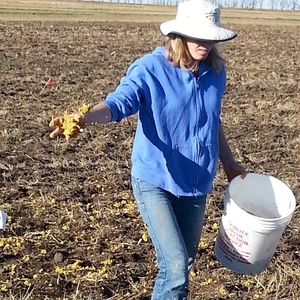NDSU scientists study distillers grains as fertilizer

North Dakota State University
February 9, 2017
BY North Dakota State University
Distillers grains could be a source of fertilizer for some crops, according to research at North Dakota State University’s Carrington Research Extension Center.
Wet distillers grains and condensed distillers solubles (sometimes referred to as “syrup”) are organic byproducts of ethanol production from corn.
Scientists at the Carrington center have been testing whether wet distillers grains and condensed distillers solubles are a viable source of phosphorus for corn and spring wheat crops. They applied those byproducts, as well as triple superphosphate, a fertilizer with a high phosphorus content, at various levels.
Here’s what they found:
Advertisement
Advertisement
Corn yield in 2016 increased by about 4 bushels per acre when phosphorus (P2O5) was applied at the rate of 40 pounds per acre.
Wheat yield increased by 2 bushels per acre when phosphorus was applied at the rate of 40 pounds per acre and by 5 bushels when phosphorus was applied at the rate of 80 pounds per acre.
In 2016, corn yields were significantly higher from applications of wet distillers grains than the other phosphorus sources, but in 2015, condensed distillers solubles produced much higher yields.
Wheat yield also increased significantly with wet distillers grains applications, compared with triple superphosphate, and applications of condensed distillers solubles produced higher yields than triple superphosphate but not as high as wet distillers grains.
“These results indicate that there are nutrient benefits to crops from using distillers grains as sources of crop nutrients,” says Carrington center soil scientist Jasper Teboh, who is involved in this research.
Advertisement
Advertisement
He speculates that nutrients in distillers grains such as sulfur may have enhanced the effect of the wet distillers grains and condensed distillers solubles. The yield gains from the distillers grains also probably are due to enhanced microbial activity. However, the scientists aren’t sure why the yields from the wet distillers grains were better than from the condensed distillers solubles in 2016 but not in 2015.
Teboh also cautions that the use of distillers grains may not be feasible for all producers.
“Preliminary assessment of net returns to farmers suggests that only producers farming within close proximity to ethanol plants are more likely to benefit from using distillers grains as fertilizer sources because of transportation costs,” he says. “As of early 2016, condensed distillers solubles cost much less ($5 per ton) than wet distillers grains ($30 per ton), and cost about $25 for an applicator to haul and apply within 25 miles of an ethanol plant.”
Visit the Carrington Research Extension Center’s website at http://tinyurl.com/DistillersGrainsasP for more information about this research.
Related Stories
U.S. fuel ethanol capacity fell slightly in April, while biodiesel and renewable diesel capacity held steady, according to data released by the U.S. EIA on June 30. Feedstock consumption was down when compared to the previous month.
The U.S. EPA on July 8 hosted virtual public hearing to gather input on the agency’s recently released proposed rule to set 2026 and 2027 RFS RVOs. Members of the biofuel industry were among those to offer testimony during the event.
The USDA’s Risk Management Agency is implementing multiple changes to the Camelina pilot insurance program for the 2026 and succeeding crop years. The changes will expand coverage options and provide greater flexibility for producers.
The USDA’s National Agricultural Statistics Service on June 30 released its annual Acreage report, estimating that 83.4 million acres of soybeans have been planted in the U.S. this year, down 4% when compared to 2024.
SAF Magazine and the Commercial Aviation Alternative Fuels Initiative announced the preliminary agenda for the North American SAF Conference and Expo, being held Sept. 22-24 at the Minneapolis Convention Center in Minneapolis, Minnesota.
Upcoming Events










